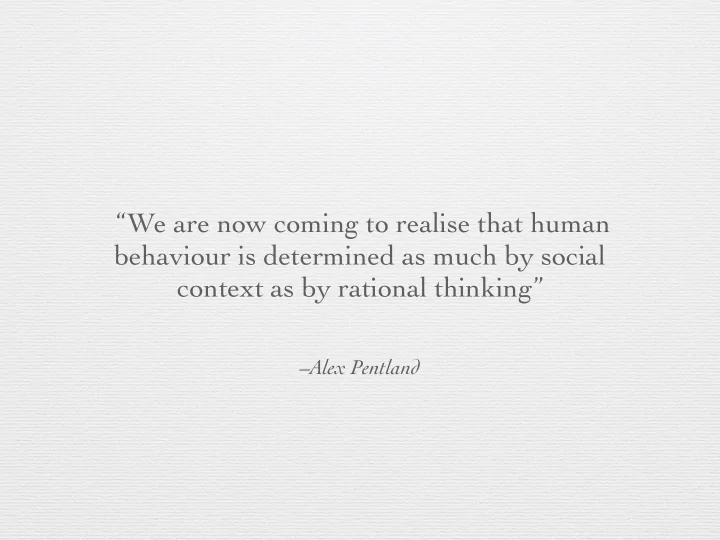

“We are now coming to realise that human behaviour is determined as much by social context as by rational thinking” –Alex Pentland
The Stubborn-Effect in Opinion Dynamics - an attempt to forecast “Brexit” Cynthia Zeng CID: 00923802
Agenda 1. Introduce background 2. Introduce the Galam sequential model 3. Model results 4. Application to “Brexit” forecast
What is agent-based modelling? • “An agent-based model ( ABM ) is a class of computational models for simulating the actions and interactions of autonomous agents with a view to assessing their effects on the system as a whole.”
Galam Sequential Model • Assumption: there are individuals in the society who are “louder” and more influential than others. • Some definitions: • A- B opinion: A = Brexit • Agent nature: stubborn (a, b) or open-minded • P_t= support for A at time t • “Social rules” : distribute, update, shuffle
Interaction example Solid = Stubborn, Hollow=open-minded A is local majority A A B B A A A A B A
Studying theoretical model • Q: studying how does the initial make-up of stubborn agents alter the dynamics of the system • Study for r=3 case, polynomial of degree 3.
Key Equations ~ Binomial( r , p_t ) : two outcomes, group size r, one outcome with probability p_t Simple Model: Mixed Model:
Sample results for mixed Model, r=3: P_C does not exist, P_A is the only fixed P_C =0.35, we need 35% “Brexit” votes in point: at this level of stubborn-A and a poll to have the “Brexit”. When stubborn-B, initial support doesn’t matter, stubborn-A is higher than stubborn-B, the outcome is determined. We call this P_C skewed to the left. AW (absolute winning) situation.
Theoretical model conclusion: AW: outcome is • determined by the level of stubborn agents. non-AW: outcome • depends on the initial support. Colour intensity: • how “certain” we are about our forecast.
Changing r size 1. Computer simulation 2. Sufficient population size: 1500 3. Measure P_final: after infinite iterations (shuffles) 4. “Jump” means non-AW, and vice versa.
Sample results r=3: AW situation r=5: non-AW situation P_C
Computer simulation results: • Theoretical calculations are verified • Smaller r lead to enhanced stubborn- effect
Model conclusions: 1. The level of stubborn agents separate the outcome into 2 situations: • AW: outcome is determined by stubborn agents • non-AW: outcome depends on the initial support. 2. Depending on the group size, as r decrease, stubborn-effect is more dramatic.
Voting Context: “Brexit” Three remarkable points: 1. Increasing level of connectivity: internet reduce r 2. High level of open minded: younger generation 3. Emotional campaigns -> angry & stubborn voter
Forecast strategy: using poll data to estimate a, b, P_0 ICM survey Source: https://www.icmunlimited.com/wp-content/uploads/2016/06/13-Jun.pdf
Raw data & estimation methodology ICM stubborn leave stubborn remain total leave votes total remain votes Total voters 08/04/2016 621 534 796 866 1945 20/05/2016 651 548 783 885 1946 YouGov 25/04/2016 482 512 688 711 1650 05/06/2016 649 637 843 885 1945 17/06/2016 608 574 742 746 1641 Survation 15/06/2016 333 291 416 815 total voters = vote leave + vote remain + uncertain a= absolutely certain leave / total voters b= absolutely certain remain / total voters P_0= leave / (leave+ remain)
Poll Data ICM Survey - ONLINE & Telephone a b P_0 08/04/2016 32% 27% 48% 20/05/2016 33% 28% 47% YouGov Survey - ONLINE 25/04/2016 29% 31% 49% 05/06/2016 33% 33% 49% 17/06/2016 37% 35% 50% Survation - Telephone 15/06/2016 41% 36% 51% ICM Survey Model Prediction Poll Prediction 08/04/2016 Brexit Brexit • Model prediction and poll prediction 20/05/2016 Brexit N/A differ. In general, model prediction YouGov Survey outperforms poll prediction. • For some poll results: e.g. ICM, 25/04/2016 Remain Brexit performance is persistent, and with 05/06/2016 Remain - uncertain Remain high conviction from an early date. Brexit Remain 17/06/2016 Survation Brexit Brexit 15/06/2016
In some cases, assumption for r size doesn’t matter… If we test for r=5,7, result is the same that Brexit ICM Survey April 8, 2016 happens. Because initial support P_0 surpasses critical point. a b P_0 32% 27% 48%
Further Research: - Open to ideas & suggestions :) - Network Structure - Drop the assumption of infinite shuffle - People become stubborn after a while
Thank you Special thanks to: Andrew & Rob H
References • Backstrom, L., Boldi, P., Rosa, M., Ugander, J. & Vigna, S. (2011) Four Degrees of Separation. • Galam, S. (2011) Collective beliefs versus individual inflexibility: The unavoidable biases of a public debate. Physica A: Statistical Mechanics and its Applications. 390 (17), 3036-3054. • Ipsos Mori. (2015) A third of young people think social media will influence their vote . Available from: https://www.ipsos.com/ipsos-mori/en-uk/third-young-people-think- social-media-will-influence-their-vote?language_content_entity=en-uk [Accessed 1st June 2017]. • Pentland, Alex,,. (2014) Social physics : how good ideas spread-the lessons from a new science. • White, M. (July 2) The Brexit vote aftermath, explained: a wild week in UK politics . The Guardian.
One-parameter
Take r=3, a=b=0 : no stubborn agents P_C =0.5, meaning we need 50% “Brexit” votes in a poll to have the “Brexit”.
Flow 2: a=0.19, b=0.10 19% stubborn-Brexiters, 10% stubborn-Remainers P_C =0.35, we need 35% “Brexit” votes in a poll to have the “Brexit”. When stubborn-A is higher than stubborn-B, P_C skewed to the left.
Flow 3: a=0.25, b=0.10 25% stubborn-Brexiters, 10% stubborn-Remainers P_C does not exist, P_A is the only fixed point: at this level of stubborn-A and stubborn-B, initial support doesn’t matter, the outcome is determined. We call this AW (absolute winning) situation.
a=0.15, b=0.1, r=3: non-AW, P_0=0.47
a=0.2, b=0.1, r=3: AW for A
r=5: non-AW, P_0=0.43 Jump!
a=0.27, b=0.26, r=3: AW for A
Group size r=5 Confused….
Group size r=7: non-AW Jump!
Recommend
More recommend